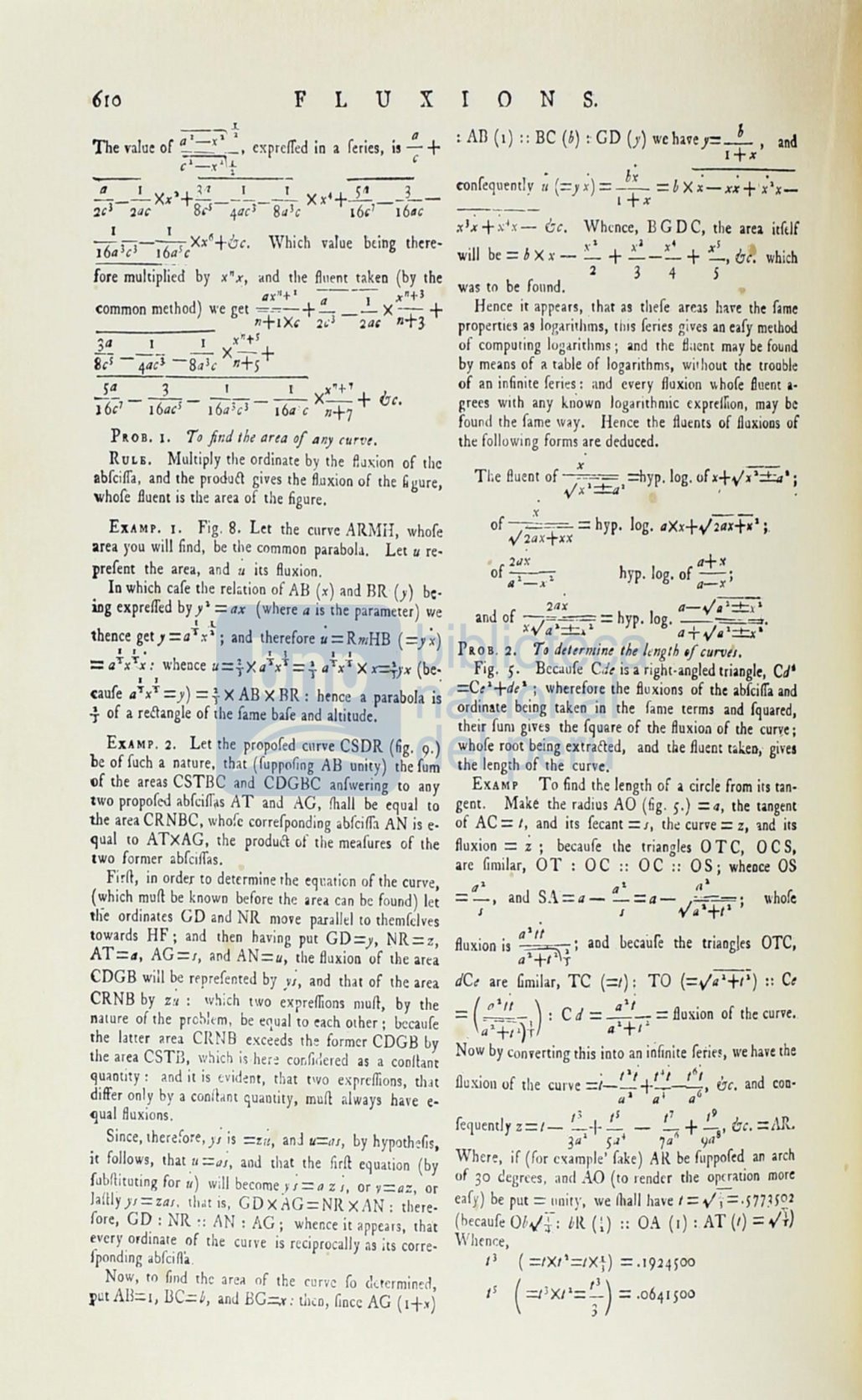

6[0
F
L
u
X 1
o
N
s.
-~-}
•
:. AD
(1)::
BC
(b)
:· GD
(y)
wchavey==_~_,
and
'fhe value of
~=:
'_.
cxprcffed in a feries, is
7
+
(+
x
(C;i'\{
~
.
b;
o. .
-
ronfequently"
(==y x) == -_ ==bX.-xx+·.'x-
.!-_~Xx '+!:_-~_-~
Xx,+2 __
L -
l
+ x
2,l
2a(
s,,
4ael Sale
16,'
16ac
--- --
xJ~+ ~'x -
&,.
Whcnce, BG DC, the area il(df
1 6:~-I;alcXx6+&(.
Which value bting there- will be ==
b
X
x
_
~
+
.::. _~
+
~,
(;c.
which
-
-
(
2
3-
4
5
fore mulliplied by
x"x,
and the fl nenl taho by Ihe was lo be fonnd .
4 ):'''+1
-.--1
xn+l
.
h
l
r
l
r
common melhod) we gel
=~-+
¡ __
X
-+
+
Hence 1l appears, 1 at as t ¡e,e areas lave Ihe ¡¡me
n+ IX,
u
2.&
n
3-
properties as IOp,Millllns,
tlm
feries gives ao eafy metbod
3a
1
1
x"t '
of compuling logarilhOls; and Ihe fiaent may be found
8(¡ -
4aCi
- Saje
X
n
+
5
+
by meaos of a lable of logarithms, willlOUI the Irooble
_ í
a_
__3_
_1_
__1_
x.,+
'
+
LC.
of ao i"bnile feries: and every fluxioo "hofe Buent
a-
<.:1
~rees
wilh aoy kn'owo logarilhOlic explclfion, may be
16,'- 16ac' -
16a;,J -
160'c
n+7
founel Ihe (ame IVay. Hence Ihe flueOls of fluxioos of
P~O D.
J.
r o¡nd Ih,
ar(a
o¡
any rurv(.
R
VLB .
Mulliply Ihe ordinale by Ihe
R~xion
of Ihe
abfciffa, and Ihe produll gives Ihe flllxion of Ihe
~gure,
whofe fiuenl is Ihe area of Ihe figure.
EUMP . l .
Fig.
S.
Let Ihe enrve ARMH, who(e
area )'OU wil! find, be Ihe common parabola. Lel
u
re–
preCeot the area, and ,; ils fluxion.
In whieh ea(e the rel'lioo of AB
(x)
and BR
(y )
be–
ing expreffed by
y'
=
ax
(where
a
is Ihe parammr) we
I .
.l
•
.
tbeDee gct}
=
a
T
x'
;
and lherefore
u
= RmHB (=
y
x)
I
f.
I
1
I
I
=
aTx'-x:
wheDee u=i-X
OTXT
=
T
a
T XT
X
=T)'x
(be-
caufe
a
~.T
=
y)
=
T
XAB XRR:
h~nee
a parabola
i~
;. of a rellaogle of the Came bafe and altitude.
EXAMP.
2.
Lellhe propofed curve CSDR
(6g. 9.)
be of (ueh a nature. Ihal (fuppoC,ng AB unilY) Ihe fum
of
the areas CSTBC and CDGBC an{lVering
10
aoy
1100
propofcd
abfci{f~s
AT and AG, {hall be cq ual
10
lhc area CRNBC. whore correfponding abCeiff.l AN is e–
qual
10
ATxAG, Ihe produél
01'
Ihe mea(ures of Ihe
two former abfciffas.
Fidl, in order lOdelermineIhe eqnalicn of Ihe curve,
(whieh mufl be known before the arca can be found) let
Ilie ordinales CD and NR move paralld
10
IhemCclves
lowards
HF;
and then having pUl
GD=y,
NR= z,
AT= ••
AG=I,
and
AN=u,
Ihe fluxioo of lile area
COGB will be rrpre(enleu by,;, aod Ihat of lhe area
CRNB by
ZI;:
\V~ich
IIVO ;xprellions mufl, by the
nalure of the prchlem, be
e~ual
10
~aeh
other; bccaue
the Imer
area
CRN8 exceeds Ihe former COGa uy
the area CSTB, which il
her~
cor,C,rlcred as
a
cooHant
quanlity: and il is (vident, Ihal
I\VO
expreffioos, Ihal
differ only by a cooH, nl quanlily. mufl . Iways have e–
<¡ual Ruxions.
Since, Iherefore,); is
=,,;,
anJ
U=OI,
by hypolheC,s,
jI follows, Ihal." =.;, and Ihal Ihe C,rfl eguation (by
CubHiluling for
11)
lVill beeome );
=
n
z;, or
y=oz,
or
hHly)'/=zal.
IlI dI
is, GOXAG=NRXAN : Ihere–
fore,
G~
: NR :: AN : AG; whence il appears, Ihat
every ordlnale of Ihe curve is reciprocally as ils corre–
Cponding abfciO'.
NOVl,
10
C,lId Ihe are. of Ihe cu rve (o ddcrmined
pUIAB::; I, UC.:: v, aod
BG=.r:
Ih,o, fioce AG (I+.,j
Iht follolVi ng forms
~re
deduced.
T he fluenl of
~---=
=hyp.log. of
'+v"=!::,,'
¡
. .v
X1
±.tJ'
.
.
of
~==-
=
hyp. log.
aXx+V2aXt.'
¡.
V2ax+••
of
2~X
,
.
-.
a+ .
v
hyp. log. of
;;=;;
212~
a-v,
l±7i
aod of
""'7==
= hyp. log.
-==.
Xva¡±'ll.
a+V
4l1
::t:x'
PiOD. 2.
ra d,lumine Ih( Imglh'¡cunm.
Fig.
5.
Bec.llfe
Cd(
is
a
righl.angled Iriangle,
Cd'
=C,'+d,'
;
wherefore the fluxions of the abCcill'a and
ordinale bciog taken in Ihe fame lerms and fquared,
their fum gives the fquare of the fluxion of tite
cur~e;
whofe root being extraéted, aod Ihe fiucO! laleoi givcs
the length of Ihe curve.
EXAMP
To find the lenglh of a eirele from in tan-
gen!. Maké the "dius AO (fig.
5.)
=4, the tangenl
of AC = 1, aod its {eeaol =
1,
Ihe curve = z, lnd ils
fluxion =
~;
beeau(e Ihe triangles OT C, O
CS,
are Gmilar,
01' :
OC: : OC ::
OS;
wheDee
OS
dl.
1
(1 1
=_, ano SA=a-
~ =a-.;=--=;
whofe
1
1
0'+1'
fluxion is
~;
aDd becaufe rhe triaogles
OTC,
0'+1";-
dC,
are Gmilar, TC (=1): TO (=';"+(') ::
C(
=
( :':'~-, )
: C
d
=~,
=
fluxion
oC
Ibe curve.
, Q'+I')-r
a
+1 .
Now by convertiog Ihis iDIOan infinile (eiie!, we have Ihe
.
.
I'i
tJi
t
Ó ;
,
flUXlO1I
of Ihe CUl'ye =1-_ + _ _ _ . ,
ve.
and eoo-
u' al
Q
1;
l '
1)
(9
- AR
fequendy z=l-
_+ _ _ _
+-.'
be.
-
v
3.'
p'
7a'
ya
Whcre, if (for
c~ample'
fake) AR be ftlppo(ed.
an
arch
uf 30 c!cgrees, :lOd
AO
(10 I'ender Ihe
o~alron
more
caey) be pUl
=
I1l1il)', \Ve Olall have 1
=
v \· = · í77.15~2
(becauCc
ob.¡I:
vR
(i) ::
OA
(1):
AT
(1)
=
Al
Whenr.e,
IJ
(=IXI'=IX ~)
= .1924500
Il (=tJXI'= T ) = .064 15°0
















